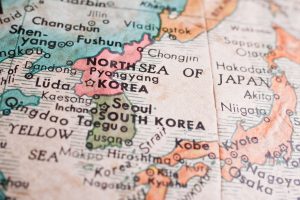Commercial satellite images suggest a resumption of construction activity at North Korea’s nuclear testing ground nearly four years after leader Kim Jong Un declared the site’s closure and invited foreign journalists to observe the destruction of tunnels ahead of his first summit with then-U.S. President Donald Trump.
Analysts say it’s unclear how long it would take North Korea to restore the site for nuclear detonations if it intends to do so. The site in Punggye-ri in the country’s northeast was used for its sixth and last nuclear test in 2017.
The sighting of construction activity at the site comes amid a deepening diplomatic freeze since the collapse of the second Kim-Trump meeting in February 2019, when the Americans rejected North Korean demands for major sanctions relief in exchange for a partial surrender of its nuclear capabilities.
North Korea has used the pause in talks to further expand its military capabilities, including nine rounds of missile launches in 2022 alone. The unusually fast pace indicates an intent to pressure the Biden administration, which has offered open-ended talks but shown no willingness to concede on sanctions.
Kim presided over a ruling Workers’ Party meeting in January where Politburo members denounced what they described as U.S. hostility and issued a veiled threat to resume tests of nuclear explosives and long-range missiles, which Kim unilaterally suspended in 2018 to create diplomatic space with Trump.
Some experts say Kim is reviving an old playbook of brinkmanship to extract concessions from Washington and his neighbors as he grapples with a decaying economy crippled by the pandemic, mismanagement and persisting U.S.-led sanctions.
The new construction at Punggye-ri was first reported in an analysis of satellite images from Maxar Technologies by Jeffrey Lewis and Dave Schmerler at the James Martin Center for Nonproliferation Studies at the Middlebury Institute of International Studies.
Satellite photos from Planet Labs PBC analyzed Tuesday by The Associated Press showed two new structures appeared to have been built to the site’s south between February and early March. Those images were taken on March 6, two days after the Maxar images used by Lewis and Schmerler.
The analysts said the construction work was the first activity they saw at the site since May 2018, when North Korea invited a group of foreign journalists to observe the destruction of tunnels at the site. North Korea didn’t invite outside experts capable of certifying what had been destroyed.
“We see very early signs of activity at the new site, including construction of a new building, repair of another building, and what is possibly some lumber and sawdust,” Lewis and Schmerler wrote. “North Korea uses a substantial amount of wood at the site both for buildings and shoring up tunnels. These changes have occurred only in the past few days.”
This indicates North Korea has made a decision about the status of the site and possibly plans to bring it back to a state of readiness to resume nuclear testing, the analysts said.
“The test site is many months, if not years, from being ready for North Korea to conduct nuclear explosions there,” they wrote.
“How long it would take North Korea to resume explosive testing at the site depends on the extent of the damage to the tunnels themselves, something we do not know with confidence. It is also possible that North Korea will resume nuclear testing at another location.”
Some South Korean analysts have said North Korea could possibly resume nuclear tests in the coming months to move the needle with the Biden administration, which has been preoccupied with Russia’s escalating invasion of Ukraine and a regional confrontation with China.
The U.S. intelligence community’s annual threat assessment, published Tuesday, also warned that there could be a new nuclear test by North Korea this year.
“In January, North Korea began laying the groundwork for an increase in tensions that could include (intercontinental ballistic missile) or possibly a nuclear test this year — actions that Pyongyang has not taken since 2017,” the assessment said.
The weapons North Korea flight-tested this year include a purported hypersonic missile designed to evade regional missile defense systems. Some experts say North Korea may use another nuclear test to claim it has acquired an ability to produce a nuclear warhead small enough to fit on that missile.
Following North Korea’s latest launch on Saturday, which it claimed was related to technologies for a spy satellite it is developing, South Korea’s presidential office revealed that Seoul is closely monitoring the Punggye-ri site along with other North Korean nuclear and missile facilities.
Meanwhile, South Korea’s military said it fired warning shots at a North Korean patrol boat that temporarily crossed the countries’ disputed western sea boundary while chasing an unarmed North Korean vessel.
The North Korean patrol boat crossed the so-called Northern Limit Line on Tuesday morning while pursuing the vessel in waters near South Korea’s Baekryeong island and retreated after a South Korean naval ship fired warning shots.
South Korean military officials seized the North Korean vessel being chased by the patrol boat and were questioning its seven crewmembers.
South Korea’s navy has often fired warning shots to repel North Korean vessels crossing the countries’ poorly marked sea border, but there also have been some deadly clashes over the years. South Korea blamed North Korea for an attack on a South Korean warship that killed 46 sailors in 2010, but the North has denied responsibility.
South Korea has patrolled waters around the Northern Limit Line for decades after it was drawn up by the U.N. command at the end of the 1950-53 Korean War. North Korea does not recognize the line and insists upon a boundary that encroaches deeply into waters currently controlled by the South.
The incident came a day before South Koreans vote in a highly contested presidential election. The bitter campaign has been marked by clashes between major candidates over whether South Korea should continue pursuing engagement with North Korea or take a harder line to check its nuclear threat.

































